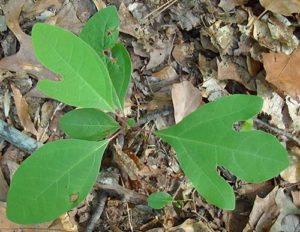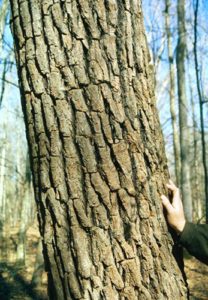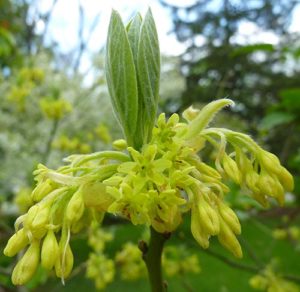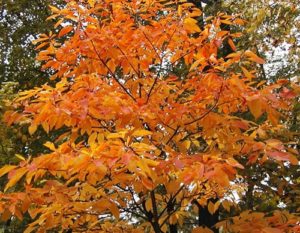Sassafras (Sassafras albidum) is native to most of the eastern U.S. It is commonly found growing in fencerows, along the edges of woods, along roads or other right-of-ways, in forest openings, and in other sunny to mostly sunny locations. In more mature forests, small sassafras saplings can often be found waiting for a canopy opening to occur which would allow more light to reach the forest floor and thus stimulate their growth. Sassafras can also be planted as a native, ornamental tree in a landscaped setting.

The growth form of sassafras can either be that of a single-trunked tree or as a multi-trunked clonal thicket. Damage to the roots or to the trunk promote additional root sprouts which leads to the thicket formation. Single-trunked trees typically grow 20-50 feet tall, but they can grow taller. According to the Champion Tree National Register, the largest sassafras in the country is 62 feet tall, has a crown spread of 51 feet, and is found in Daviess County, KY. It was last measured in 2016.
Sassafras are deciduous trees, meaning that they lose their leaves each year. However, when they have their leaves, they are very easy to identify. Sassafras have three different leaf shapes – all of which can be found on the same tree. The first leaf shape is pretty much a basic, generic leaf shape. The second leaf shape has two lobes and is reminiscent of a mitten, which is why it is often referred to as a mitten leaf. Mittens can be either right or left-handed depending on where the “thumb” is located. The third leaf shape has three lobes and is often referred to as a glove where the side lobes represent the thumb and pinky and the middle lobe represents your middle three fingers.

Just as a side note, I think I remember reading once upon a time that some sassafras trees tend to be more left-handed and some tend to be more right-handed. However, I can’t find anything about that now, so I’m not sure if it is true. (You know, looking at the relative proportions of different leaf shapes, especially right and left-handed mittens, on a number of sassafras trees might be a relatively straightforward and interesting research project. If someone was interested in doing such a project, be sure to look at leaves from all over the tree and not just at eye level because some research indicates that certain sassafras leaf shapes are more likely to occur lower on the tree vs. higher on the tree.)
In addition to its multi-shaped leaves, sassafras can be identified by its smell. When crushed, the leaves have a distinct spicy smell. Also, if you scrape the bark off a section of a young sassafras twig, it has a lemony smell that reminds me of the lemon-scented Pledge that everyone used to dust with when I was growing up. The bark on a mature trunk is also very distinctive. It tends to be a yellowish to brownish gray color that often gets kind of corky, sometimes with interlacing ridges. It’s hard to describe and can vary with the age of the tree, but once you get the search image, it is easy to pick out. The bark also has a unique smell if you break some of it off, but I’m more likely to smell the leaves or a twig than the bark.

Sassafras blooms in the early spring, usually right before or just as the new leaves start to appear. The small, yellow flowers bloom in clusters. Some trees will only produce female flowers. Other trees will only produce male flowers. The flowers are pollinated by bees (usually smaller bees) and several types of flies. Lots of other insects also visit the flowers to gather nectar and/or pollen, but usually don’t do much in the way of actual pollination. Later in the summer, the pollinated female flowers will produce clusters of dark blue-black, berry-like fruit. The fruit are eaten by a wide variety of songbirds.
Spicebush swallowtail caterpillars and the caterpillars of a bunch of different moths, including several of our large silk moths, use sassafras as a host plant and will eat the leaves. However, none of these caterpillars occur in such great numbers that you are likely to notice that they’ve been munching on the leaves unless you are actively looking for them. In the fall, sassafras leaves turn a variety of colors ranging from bright yellow, to brilliant orange, to scarlet red or even burgundy. The fall foliage alone makes it a great choice for a specimen tree in a landscape setting.

Sassafras also has a long history of human use. Many different Native American tribes used it to treat a wide range of illnesses. They taught the early European colonists how to use it, and for a while sassafras was a valuable export to Europe. In addition to its historical medicinal uses, sassafras also has a long culinary history. The roots were made into root beer and either the leaves or the roots were made into tea. The dried and ground leaves are also part of traditional Cajun gumbo recipes and I’ve read that the flowers can be eaten in salads. Sassafras isn’t used in commercially produced food or drugs anymore because some early studies suggested that one of the natural chemicals in sassafras can be carcinogenic, at least in lab animals. The wood isn’t used much anymore, but in the past was used for bedstands, cribs, fenceposts, livestock pens, cooking utensils, crates, and other items.
Unfortunately, sassafras is one of the trees susceptible to laurel wilt disease. Laurel wilt disease is caused by an exotic, invasive fungus that is spread by the exotic, invasive redbay ambrosia beetle. Laurel wilt was first detected in the U.S. in the early 2000s. It quickly devastated the redbays (Persea borbonia), a tree native to the southeastern Atlantic Coastal Plain. Since redbays have such a limited range, scientists at first thought that laurel wilt may be confined to the coastal plain. But, that was not the case. The disease has continued to spread and infect other trees in the Lauraceae family, including sassafras. In 2019, it had been detected as far north as Kentucky. I haven’t heard reports for how much further it has spread in 2020.
If you see wilting sassafras trees, or other trees in the same family, in the spring or summer, please let your state forestry department know so they can check it out. There are currently no known cures or treatment options for laurel wilt disease, but tracking its spread is still important. It is also important to do everything we can to not spread it which means being very cautious about any plants we buy in the laurel family and not moving uncured wood products (including firewood). Sassafras are one of my favorite trees and we have lots of them on our farm. I’m dreading what I know this disease could do.

Backyard Ecology: Exploring Nature in Your Backyard
Nature isn’t just “out there.” It’s all around us, including right outside our doors. Hi, my name is Shannon Trimboli, and I am the host of Backyard Ecology. I live in southcentral Kentucky and am a wildlife biologist, educator, author, beekeeper, and owner of a nursery specializing in plants for pollinators and wildlife conservation. I invite you to join me as we ignite our curiosity and natural wonder, explore our yards and communities, and improve our local pollinator and wildlife habitat. Learn more or subscribe to my email list at www.backyardecology.net.

Leave a Reply